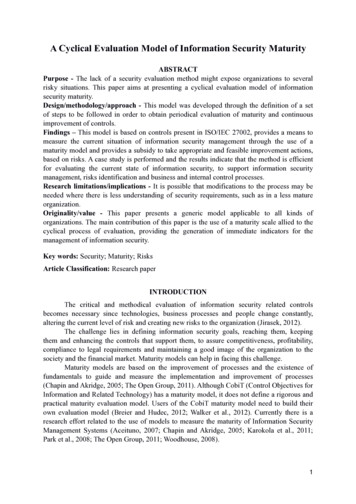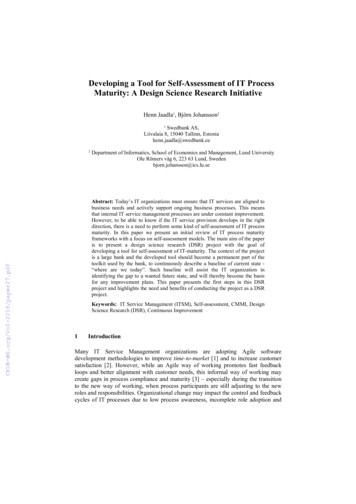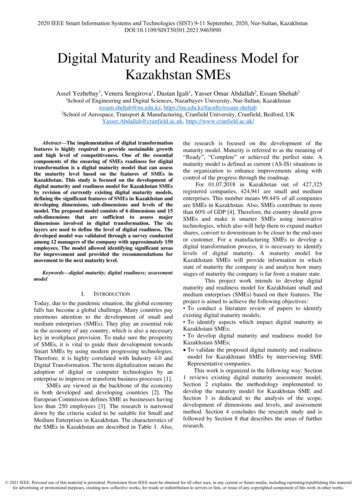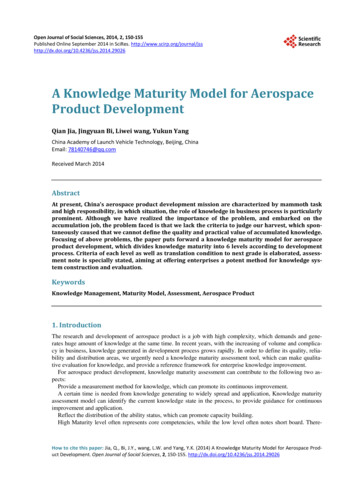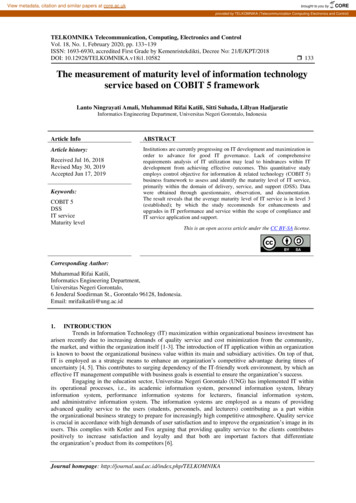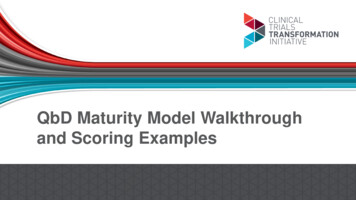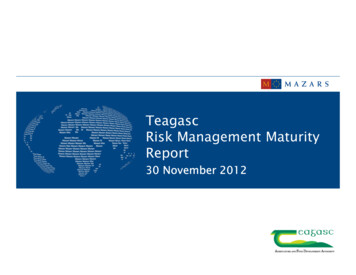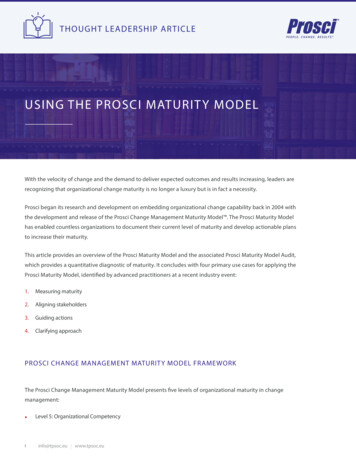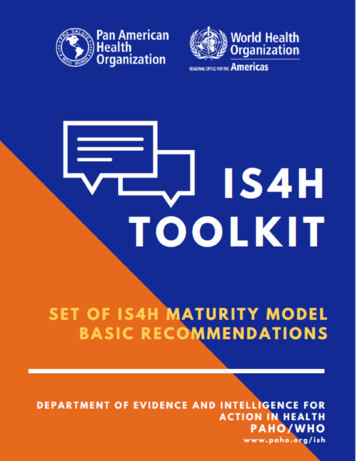
Transcription
Set of IS4H Maturity Model Basic Recommendations – Version 1.01
Set of IS4H Maturity Model Basic Recommendations – Version 1.02Information Systems for Health ToolkitSet of IS4H Maturity Model BasicRecommendationsIS4H- MMBR 1.0AcknowledgmentsThis work would not have been possible without the technical and financial support ofthe United States Agency for International Development (USAID),the Government of Canada and the Spanish Agency for InternationalDevelopment Cooperation (AECID)Version 1.0 – October 20, 2018Department of Evidence and Intelligence for Action in HealthPan American Health Organization - World Health Organization
Set of IS4H Maturity Model Basic Recommendations – Version 1.03Set of IS4H MM basic recommendationsFrom level 1 to Level 2Data Management and Information Technologies (DMIT)ComponentDATA SOURCESRecommendations Identify key health data sources from which is critical to obtainroutine data and information, this must include:o New data sourceso Data sources randomly collectedo Data sources routinely collected Document and mandate standards for indicator definitions and keydata elements.INFORMATIONPRODUCTS Develop the conceptual architecture for a national health informationexchange platform.o Business architecture (roles, responsibilities and functions)o Define the electronic collection method from all data sourcesidentifiedo Strengthen data collection through automated processo Conduct data prioritization and mapping exercise Identify and prioritize information requirements (health indicators;health system performance indicators)o Include information reporting requirements (indicators, datasets) in Service Level Agreements (e.g. hospital, NGOs, etc.). Start the development of a data sharing framework (whatinformation is shared? with whom? Under which agreements orauthority?).o Establish a data flow map for starting sharing informationproducts with stakeholders and health facilitiesITINFRASTRUCTURE DATAGOVERNANCE Conduct an ICT in health readiness assessment for the Ministry ofHealth and the health facilities of key delivery partnersInitiate a rapid high-level due diligence assessment of NationalInformation Health System (with regions) to determine a possibleintegral implementationStart the development of a Data governance framework (see IS4HGovernance Framework).o Map present and future data flowsStart the development of a national data management policy.
Set of IS4H Maturity Model Basic Recommendations – Version 1.0STANDARDS FOR QUALITYANDINTEROPERABILITY4Adopt a data quality framework.Management and Governance (MAGO)LEADERSHIP ANDCOORDINATION Start the establishment of a formal multi-sectoral IS4H StrategicGovernance and Technical Advisory Structure.o Identify the key individual national health authorities (MOH,reginal health authorities, health facilities)o Identify the key decisions that need to be coordinated by theIS4H Strategic Governance and Technical Advisory Structure.STRATEGICAND Use the recommendation from this assessment to develop a NationalOPERATIONALIS4H Plan of Action with short to medium-term costing and resourcePLANSrequirements:o Create Roadmap & Budget to achieve IS4H Future Stateo Identify National Health System Strategic Plans in which IS4H couldbe addressedo Identify individual units/departments/facilities operational planswhere to include components of IS4Ho Develop a roadmap for addressing IS4H into National and individualoperational and strategic plansORGANISATIONALSTRUCTURE ANDFUNCTIONS Start a process for rationalizing accountability, roles andresponsibilities for IS4H functionso Identify actual IS4H-related functions performing throughthe PAHO IS4H Functional Assessment Tool andMethodology.o Identify critical needs/gaps on IS4H implementation-relatedfunctionso Develop a roadmap for capacity building / realignment torationalize functions and decision-makingo Appoint IS4H Program Lead and short-term project team.o Define organizational functions foro Information Technology Managemento Information Management and Analysiso Health Informaticso Knowledge and Performance Management
Set of IS4H Maturity Model Basic Recommendations – Version 1.0 HUMANRESOURCES FINANTIALRESOURCES 5o Conduct IS4H Functional Assessment in order to identifyessential IS4H functions that must be performed in thecountryInvest in technical support for the development and implementationof a change management strategy in support of IS4H capacitybuilding.Develop a medium to long-term organizational structure and humanresource strategyo Identify/document human resource constraints for planning,implementing, and managing IS4H through applying thePAHO IS4H Functional Assessment Methodology.o Develop a roadmap for addressing Human Resources IS4HneedsEstablish with adequate stakeholders a strategic planfor ensure the existence of academic undergraduateeducation capacity in country.o Add change management and project managementskills/functions to IS4H implementation team (short-term)and program team (longer-term)Identify the IS4H activities from in individual unit/program thatneed to be incorporated annual budgets of national healthauthorities.Identify the financial resources requirements to effectively sustainIS4H with the correspondent operational budget where to beincluded Start a process of enabling multisectoral collaboration for IS4Ho Identify other public sector stakeholder that are key forspecific health information and service needs.o Develop engagement activities to enable collaborationamong sectorso Develop a roadmap for multisectoral collaborationestablishment.LEGISLATION POLICYANDCOMPLIANCEConduct analysis and remediate gaps in legal/regulatory frameworkfocusing on:o Protection of personal health information (privacy)o Mandatory reportable diseases and conditionsNATIONALAND INTERNATIONALAGREEMENTSCreate a health agreements commission to start the process ofaccomplishment of national and international health agreementsMULTISECTORALCOLLABORATION
Set of IS4H Maturity Model Basic Recommendations – Version 1.0 6Identify National and International health agreementsactually in placeIdentify National and International health agreements thatare not being addressedIdentify individual unit/program that should be involvedwith the in place and future agreements.Develop a road map for addressing in place a futureagreements needsIS4H Strategic Plan Development ApproachKnowledge Management and Sharing (KMSH)KNOWLEDGEPROCESSES Implement basic knowledge management mechanisms withinMOH to initiate knowledge sharing (e.g. lessons learned,communities of practices).o Identify, based on knowledge management needs,which existent methodologies would be integrated forknowledge management and sharingKNOWLEDGEARCHITECTURE Start implementing organizational learning culture
Set of IS4H Maturity Model Basic Recommendations – Version 1.07o Identify individual unit/program that could be KMchampions among the organizationo Develop a road map to be a learning organization Identify and participate in regional and sub-regional IS4Hcommunities of practice (e.g. RELACSIS, IS4H Technical AdvisoryGroup).ACADEMIA/SCIENTIFIC COMMUNITYIdentify and establish a road map for the establishment offormal national, regional and sub-regional relationships withacademic/research institutions.o Identify which academia and research health institutionsare in countryo Select and establish contact with those academia andresearch health institutions from which relation shouldbenefit public health issueso Discuss collaboration issues with academia and researchhealth institutions Strengthen the use of communication mechanisms within MOHto begin relations with public and stakeholders (dynamicwebsite, social networks)Start the development of a Communication StrategyNETWORKSSTRATEGICCOMMUNICATIONS SOCIALPARTICIPATIONStart a process for social engagements in public health throughsocial media and formal roles on governance bodies andadvisory groupsInnovation (INNO)KEY CONCEPTS TOOLS Develop a capacity building road map for staff knowledgestrengthening on IS4H knowledgeDevelop a training road map for staff digital literacyRun Maturity Model of the National EHR System: Country andmaturity level report with recommendations
Set of IS4H Maturity Model Basic Recommendations – Version 1.0 8Identify health analysis tools requirements to enable data analysisand the development of information products/key indicators (seeDMIT Recommendations above)o Analyze existing health analysis tools in placeo Identify gaps in health analysiso Identify learning opportunitieso Develop a roadmap for routine data analysis and datastorageStart the implementation of a health analysis for decision makingroadmap/strategyo Identify data that needs to be available for reports andhealth status outcomes generationo Identify health analysis focus needs for decision-makingo Map data flows needs to support decision-makingo Map data availability needsHEALTH ANALYSISFOR DECISIONMAKING DIGITAL HEALTH Conduct a Digital Health assessment, to identify:Tools implementation needsDigital Health roadmap considering focus movements:o digitizing manual processeso improve operational efficiencieso transform models of care,o improve patient safety and quality of care,o supporting population health approaches.o facilitate targeted communications to individualso stimulate demand for services/access to health informationo improve decision support mechanisms /telemedicine.o enables population health managemento rapid response to disease incidents and public healthemergencieseGOVERNMENT Ensure health sector is fully engaged in e-Gov planning andinitiatives.OPENGOVERNMENT Sensitize stakeholders on the benefits of open dataPREPAREDNESSAND RESSILIENCE Create a preparedness commission to improve response andresilience actions:
Set of IS4H Maturity Model Basic Recommendations – Version 1.09o Identify multisectoral health stakeholderso Identify basic approaches for critical areas to ensurebusiness continuity in the case of disastero Identify key data sets to be available to support disasterresponseo Develop a roadmap to ensure a growing up improvement inthe areaFrom level 2 to Level 3Data Management and Information Technologies (DMIT)DATA SOURCES Identify the information needs for key MoH stakeholders (e.g. MoHleadership, program leads, planners, etc.) and other stakeholders(health facility administrators and clinicians) ando Include information reporting requirements (indicators, datasets) in Service Level Agreements (e.g. hospital, NGOs, etc.). Identify key health data sources from which is critical to obtainroutine data and information, this must include:o New data sourceso Data sources randomly collectedo Data sources routinely collected Document and mandate standards for indicator definitions and keydata elements. Establish a shared scheduled for data collection according technicaland political needs Conduct an exercise to develop and implement a shared scheduledfor:o data collection according technical and political needso real time availability of data to support decision-makingINFORMATIONPRODUCTS Develop the conceptual architecture for a national health informationexchange platform.o Business architecture (roles, responsibilities and functions)o Define the electronic collection method from all data sourcesidentifiedo Strengthen data collection through automated processo Conduct data prioritization and mapping exercise
Set of IS4H Maturity Model Basic Recommendations – Version 1.0 ITINFRASTRUCTURE DATAGOVERNANCE STANDARDS FOR QUALITYAND INTEROPERABILITY10Identify and prioritize information requirements (health indicators;health system performance indicators)o Include information reporting requirements (indicators, datasets) in Service Level Agreements (e.g. hospital, NGOs, etc.).Start the development of a data sharing framework (whatinformation is shared? with whom? Under which agreements orauthority?).o Establish a data flow map for starting sharing informationproducts with stakeholders and health facilitiesConduct an ICT in health readiness assessment for the Ministry ofHealth and the health facilities of key delivery partnersBased on the conceptual architecture for the national healthinformation exchange platform, develop the technical architectureand phasing strategy.Strength national IT infrastructure (work stations, networks, localfacility infrastructure, government data center, support services).Initiate a rapid high-level due diligence assessment of NationalInformation Health System (with regions) to determine a possibleintegral implementationImplement a data governance framework aligned with the overallIS4H governance framework.Develop and implement national data management policy.Development and implement a national data quality framework.Implement a formal plan for standards adoption that includes:o Critical and specific data sources standardizedo Standards applicated in new data sourceso Continue de adoption of standards for data sources in theshort, mid and long term.Management and Governance (MAGO)LEADERSHIP ANDCOORDINATION Establish a formal multi-sectoral IS4H Strategic Governance andTechnical Advisory Structure.o Identify the key individual national health authorities (MOH,reginal health authorities, health facilities)o Identify the key decisions that need to be coordinated by theIS4H Strategic Governance and Technical Advisory Structure.
Set of IS4H Maturity Model Basic Recommendations – Version 1.011STRATEGICAND OPERATIONALPLANSUse the recommendation from this assessment to develop aNational IS4H Plan of Action with short to medium-term costing andresource requirements:o Create Roadmap & Budget to achieve IS4H Future Stateo Identify National Health System Strategic Plans in which IS4Hcould be addressedo Identify individual units/departments/facilities operationalplans where to include components of IS4Ho Develop a roadmap for addressing IS4H into National andindividual operational and strategic planso Key Performance Indicators to track capabilities andprogress. Start a process for rationalizing accountability, roles andresponsibilities for IS4H functionso Identify actual IS4H-related functions performingo Identify critical needs/gaps on IS4H implementation-relatedfunctionso Develop a roadmap for capacity building / realignment torationalize functions and decision-makingo Appoint IS4H Program Lead and short-term project team.o Define organizational functions for Information Technology Management Information Management and Analysis Health Informatics Knowledge and Performance ManagementInvest in technical support for the development and implementationof a change management strategy in support of IS4H capacitybuilding.Develop a medium to long-term organizational structure and humanresource strategyo Identify/document human resource constraints for planning,implementing, and managing IS4H through applying thePAHO IS4H Functional Assessment Methodology.o Develop a roadmap for addressing Human Resources IS4HneedsEstablish with adequate stakeholders a strategic planfor ensure the existence of academic undergraduateeducation capacity in country.o Add change management and project managementskills/functions to IS4H implementation team (short-term)and program team (longer-term)ORGANISATIONALSTRUCTURE ANDFUNCTIONS HUMANRESOURCES
Set of IS4H Maturity Model Basic Recommendations – Version 1.0 FINANTIALRESOURCES MULTISECTORALCOLLABORATION LEGISLATION POLICYANDCOMPLIANCE NATIONALAND INTERNATIONALAGREEMENTS12Establish with adequate stakeholders a strategic plan for ensurethe existence of academic undergraduate education capacity incountry.Add change management and project management skills/functionsto IS4H implementation team (short-term) and program team(longer-term)Develop costing for implementing the IS4H Plan of Action.o Identify available resources and initiate resourcemobilization activities where there are funding gaps.Identify the IS4H activities from in individual unit/program that needto be incorporated in annual budgets of national health authorities.Start a process of enabling multisectoral collaboration for IS4Ho Identify other public sector stakeholder that are key forspecific health information and service needs.o Develop engagement activities to enable collaborationamong sectorso Develop a roadmap for multisectoral collaborationestablishment.Conduct analysis and remediate gaps in legal/regulatory frameworkfocusing on:o Protection of personal health information (privacy)o Use of EHRStart a process for addressing ethical use and protection of healthdata within a general data protection legal framework.o Conduct analysis and remediate gaps in legal/regulatoryframework focusing on: Protection of personal health information (privacy) Security Secondary use Mandatory reportable diseases and conditionsStart a process to develop/update legislation/regulation to enablethe effective use of electronic medical records.o Identify existing guidelines or process for the use of medicalrecords and develop, based in best practices, formal policiesfor governing the effective use of electronic medical records.Create a health agreements commission to start the process ofaccomplishment of national and international health agreementso Identify existing National and International healthagreements
Set of IS4H Maturity Model Basic Recommendations – Version 1.013o Identify National and International health agreements thatare not being addressedo Identify individual unit/program that should be involved withthe in place and future agreements.IS4H Strategic Plan Development ApproachKnowledge Management and Sharing (KMSH)KNOWLEDGEPROCESSES Establish policies and procedures, as well as formalmethodologies to achieve an effective exchange of data,information and knowledge within and among institutionsthroughout the country that handle health data:o Identify all the basic knowledge managementmechanism and processes (Preservation of theinstitutional memory; Open access/open source;Research for health; Repositories; Information access;Editorial or publishing ; Mentoring; Travel reports;Meeting reports; Communities of practice; Lessonslearned; Critical Information sharing and managing;Virtual meetings; Social networking) that are currently inplace, randomly accessible and updated.
Set of IS4H Maturity Model Basic Recommendations – Version 1.0 KNOWLEDGEARCHITECTURE NETWORKS 14o Establish communities of practices for the developmentof formal policies based in the best practices ofprocesses in placeo Develop a roadmap for implementation of policiesdevelopedDefine and implement an official institutional taxonomy for theclassification of documentsStart the development of a KM strategy, that allows to generateawareness of the importance of making decisions based on upto-date, safe and reliable data;Incorporate the use of metrics to quantitatively measureorganizational knowledge management processes andcapacitiesEstablish a KM advisory group to asses MoH in:o The critical KM infrastructure needed to be a learningorganizationo Identify Knowledge management projects launched or inlaunching processo Advise on which KM projects could be of Nationalinterest to be supported by health authorities andreplicatedo Identify skills that could be integrated into MoH trainingprograms Use of scientific information for health-relateddecision making Knowledge production Knowledge management & sharing Knowledge access Use and evaluation of information technologiesin order to support health prioritiesStart the development of a methodology/process/policy tofacilitate public access to contents resulting from researchactivities financed primarily by public fundsEstablish mechanisms (forum, knowledge sharing website,listserves, etc) for sharing knowledge given and received frominternational forums and networks.Incorporate the participation in national and internationalnetworks as part of the post descriptions of critical staff.
Set of IS4H Maturity Model Basic Recommendations – Version 1.015ACADEMIA/SCIENTIFIC COMMUNITYIdentify and establish a road map for the establishment offormal national, regional and sub-regional relationships withacademic/research institutions.o Identify which academia and research health institutionsare in countryo Select and establish contact with those academia andresearch health institutions from which relation shouldbenefit public health issueso Discuss collaboration issues with academia and researchhealth institutions Develop an MoH Communication Strategy MoH to strengthen engagementand communication with the public and other key stakeholders (dynamicwebsite, social networks).Strengthen communication flow by implementing a feedback routine to thelocal level with key information needed.Implement a strategy for measurement of strategic communication impactSTRATEGICCOMMUNICATIONS SOCIALPARTICIPATIONStart a process for social engagements in public health throughsocial media and formal roles on governance bodies andadvisory groupso Identify the possible mechanisms for communicationwith the public that could be incorporated by the MoH(One way (websites, advertising, etc.), Specificcommemorative activities (campaigns), Surveys, Focusgroups, Social networks and website interaction,Participation in governance bodies, Participation inadvisory groups)o Identify critical public and private sector stakeholders tostrengthen MoH efforts on incorporate communityInnovation (INNO)KEY CONCEPTS TOOLS Implement a capacity building road map for staff knowledgestrengthening on IS4H knowledgeImplement a training program road map for staff digital literacyConduct an exercise on health analysis tools implementationo Analyze existing health analysis tools in place
Set of IS4H Maturity Model Basic Recommendations – Version 1.0 HEALTH ANALYSISFOR DECISIONMAKING DIGITAL HEALTH16o Identify gaps in health analysiso Identify learning opportunitieso Develop a roadmap for routine data analysis and datastorageStart the process of implementation of a Data warehouse (DWH)within the organizationStart the implementation of a health analysis for decision makingroadmap/strategyo Identify data that needs to be available for reports andhealth status outcomes generationo Identify health analysis focus needs for decision-makingo Map data flows needs to support decision-makingo Map data availability needsStart the development of a capacity building plan to strengthenhealth analysis through the application of different approacheso Identify knowledge, skills and human resources required tosupport health analysis for decision making. Descriptive (summary) analysis Inferential statistics Data visualization and exploratory data analysis Public health modeling Data science: Predictive analysis based on machinelearning, deep learning neural networks; clustering,anomaly, association rule mining, predictionDevelop an investment plan. Develop a digital health strategy that identifies:o Tools implementation needso Digital Health roadmap considering: Digitizing manual processes Improving operational efficiencies Transforming models of care, Improve patient safety and quality of care,o Facilitating targeted communications to individualso Stimulating demand for services/access to health informationo Improve decision support mechanisms /telemedicine.o Enabling population health managemento Rapid response to disease incidents and public health emergencies Digital Health roadmap considering focus movements:
Set of IS4H Maturity Model Basic Recommendations – Version 1.017oooooooooo eGOVERNMENT OPENGOVERNMENT PREPAREDNESSAND RESSILIENCE digitizing manual processesimprove operational efficienciestransform models of care,improve patient safety and quality of care,supporting population health approaches.facilitate targeted communications to individualsstimulate demand for services/access to health informationimprove decision support mechanisms /telemedicine.enables population health managementrapid response to disease incidents and public healthemergenciesConduct an assessment on National Health Information SystemimplementationStart the process of development of a telemedicine network in theentire countryEnsure health sector is fully engaged in e-Gov planning andinitiatives.Ensure the focus for the health sector is on strengtheningadministrative process like procurement, budget, etc. Alsoincluding IT infrastructureStart the integration of health specific public portals or health eservice with the national e-government platformSensitize stakeholders on the benefits of open dataUpdate MoH training programs incorporating Open GovernmentskillsStart the development of an Open Data PolicyRevise the organizational policies to start the integration of theprinciples of opennessCreate a preparedness commission to improve response andresilience actions:o Identify multisectoral health stakeholderso Identify basic approaches for critical areas to ensurebusiness continuity in the case of disastero Identify key data sets to be available to support disasterresponse
Set of IS4H Maturity Model Basic Recommendations – Version 1.018o Develop a roadmap to ensure a growing up improvement inthe areaFrom level 3 to Level 4Data Management and Information Technologies (DMIT)DATA SOURCES Implement routine schedule to obtain key health data andinformation from identified sources.Standardize indicators and key data elements.Implement shared scheduled for:o data collection according technical and political needso real time availability of data to support decision-makingINFORMATIONPRODUCTS Define a national health information architecture, documentinginformation flows, data catalog and availability of technologicalinfrastructure;o Establish a data flow map for sharing information productswith stakeholders and health facilities Define and develop information products based onthe stakeholders specific needs Establish and implement distribution mechanismso Develop a road map considering short, medium- and longterm actions for implementing the data sharing framework Routine for production of information productsITINFRASTRUCTURE Continue to invest in achieving as much interoperability as possiblein health information platforms, including integrated national datarepositories from multiple data sources, including sub-nationalones.o It is recommended to run an ICT in health readinessassessment for the whole ministry of health and healthfacilities to highlight the specific investments needsImplement a whole interoperability process among IT infrastructure(hardware and software) DATAGOVERNANCE Implement a Data Governance framework at the national level thatensures continuous improvement to monitor and invest in dataquality;
Set of IS4H Maturity Model Basic Recommendations – Version 1.019 Develop a plan and implement processes to strengthen alignment ofstandards, data quality frameworks and data management practicesacross all stakeholdersSTANDARDS FOR QUALITYANDINTEROPERABILITYImplement a formal plan for standards adoption that includes:o Critical and specific data sources standardizedo Standards applicated in new data sourceso Continue de adoption of standards for data sources in theshort, mid and long term.Document the national health information architectureApply a national identifier for integrating health data from allsources Management and Governance (MAGO) Establish a formal multi-sectoral IS4H Strategic Governance andTechnical Advisory Structure.o Integrated by key individual national health authorities(MOH, reginal health authorities, health facilities)o Defined ToR including: Key decisions that need to be coordinated by the IS4HStrategic Governance and Technical AdvisoryStructure. Roles and responsibilities of members Plan of action – Roadmap of key activities and results Auto evaluation planSTRATEGICAND OPERATIONALPLANSImplement an IS4H Plan of Action with short to medium-termcosting and resource requirementso Addressed IS4H in all National Health System Strategic Planso nts/facilities operational planso Roadmap – plan of action for implementationo IS4H Guiding Principles incorporated Implement an organizational structure with accountability, roles andresponsibilities for IS4H functions.o Strengthen IS4H Program Lead and project team roles andresponsibilities.o Strengthen organizational functions forLEADERSHIP ANDCOORDINATIONORGANISATIONALSTRUCTURE ANDFUNCTIONS
Set of IS4H Maturity Model Basic Recommendations – Version 1.0 20 Information Technology Management Information Management and Analysis Health Informatics Knowledge and Performance ManagementClose critical needs/gaps on IS4H implementation-related functionso Continue strengthen capacity building on IS4H to improvedecision-makingReview / implement change management strategy supported bythird party organizationHUMANRESOURCES Implement a medium to long-term organizational structure andhuman resource strategy.o Secure human resource for planning, implementing,managing and sustaining IS4Ho Implement a Human Resources IS4H needs and strengthenskills plan Training Workshops Conferenceso Incorporate IS4H skills in education, training plans in placeFINANTIALRESOURCES Implement an IS4H investment framework at the national level, toensure IS4H strategic plan sustainabilityMULTISECTORALCOLLABORATION Formalize relationships with multisectoral actors, including theprivate sectors:o Specify roles and responsibilities for specific healthinformation and service needs.o Start a process of enabling multisectoral collaboration forIS4Ho Identify other stakeholder that are key for specific healthinformation and service needs.o Develop engagement activities to enable collaborationamong sectorso Develop a roadmap for multisectoral collaborationestablishment.
Set of IS4H Maturity Model Basic Recommendations . Implement a data governance framework aligned with the overall Develop and implement national data management policy. STANDARDS FOR QUALITY AND INTEROPERABILITY Development and implement a national data quality framework.

